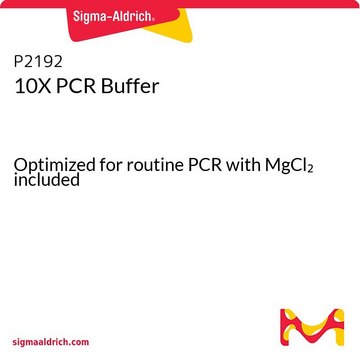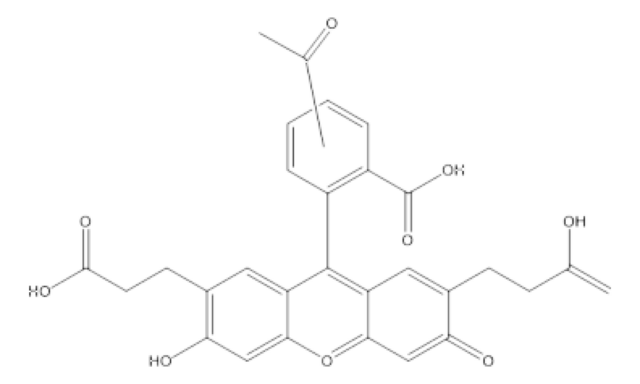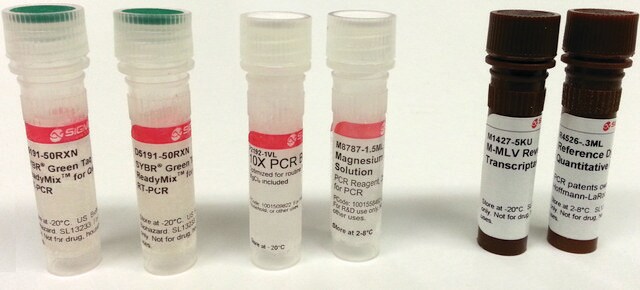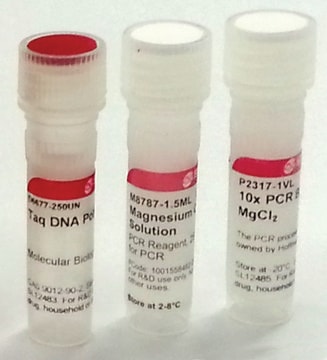MAK150
Fluorometric Intracellular pH Assay Kit
sufficient for 1000 fluorometric tests
Se connecterpour consulter vos tarifs contractuels et ceux de votre entreprise/organisme
About This Item
Code UNSPSC :
12161503
Nomenclature NACRES :
NA.84
Produits recommandés
Utilisation
sufficient for 1000 fluorometric tests
Méthode de détection
fluorometric
Maladie(s) pertinente(s)
neurological disorders; genitourinary disorders; cancer
Température de stockage
−20°C
Description générale
Intracellular pH changes are implicated in diverse physiological and pathological processes, including cell proliferation, apoptosis, fertilization, malignancy, multidrug resistance, ion transport, lysosomal storage disorders, and Alzheimer′s disease.
This kit can be utilized to measure decreases in intracellular pH in cells treated under various conditions using a simple standard protocol. Alternatively, an Acid-Load procedure can be used to measure the increase of intracellular pH associated with changes in cellular metabolism due to GPCR activation, growth factor activity, or other cellular stimulation. With the Acid-Load procedure ammonium chloride solution is added after the fluorescent pH dye is loaded into cells in a minimum volume. This Acid-Loading step is followed by the addition of agonist in a relatively large volume (~4x) of buffer. The sudden volume change initiates an efflux of ammonia (NH3) from the cells causing a rapid decrease in intracellular pH, and thus a decrease in fluorescence signal. The effect of agonist on the subsequent recovery of intracellular pH is measured by the relative fluorescence signal increase.
This kit can be utilized to measure decreases in intracellular pH in cells treated under various conditions using a simple standard protocol. Alternatively, an Acid-Load procedure can be used to measure the increase of intracellular pH associated with changes in cellular metabolism due to GPCR activation, growth factor activity, or other cellular stimulation. With the Acid-Load procedure ammonium chloride solution is added after the fluorescent pH dye is loaded into cells in a minimum volume. This Acid-Loading step is followed by the addition of agonist in a relatively large volume (~4x) of buffer. The sudden volume change initiates an efflux of ammonia (NH3) from the cells causing a rapid decrease in intracellular pH, and thus a decrease in fluorescence signal. The effect of agonist on the subsequent recovery of intracellular pH is measured by the relative fluorescence signal increase.
Application
Fluorometric Intracellular pH Assay Kit has been used to measure the intracellular pH.
Caractéristiques et avantages
Superior alternative to BCECF
Adéquation
This kit can be utilized to measure changes in intracellular pH in cells treated under various conditions.
Principe
The Fluorometric Intracellular pH Assay Kit utilizes a proprietary cell-permeable fluorescent indicator, BCFL-AM, for measuring relative intracellular pH changes. BCFL-AM is a superior alternative to the popular ratiometric pH probe, 2′,7′-bis-(2-carboxyethyl)-5(6)-carboxyfluorescein (BCECF). Unlike BCECF, which is a complex and variable mixture of isomers, BCFL-AM is a single isomer species. BCFL-AM has the same spectral responses as BCECF-AM (λex = 490 nm/λem = 535 nm for single measurement or λex = 505 nm/λem = 535 nm and λex = 430 nm/λem = 535 nm for ratio measurement) but enhanced reproducibility. BCFL-AM exhibits pH-dependent dual excitability, pKa ~7.0, and an excitation isosbestic point of 454 nm.
Code de la classe de stockage
10 - Combustible liquids
Classe de danger pour l'eau (WGK)
WGK 3
Point d'éclair (°F)
Not applicable
Point d'éclair (°C)
Not applicable
Faites votre choix parmi les versions les plus récentes :
Certificats d'analyse (COA)
Lot/Batch Number
Vous ne trouvez pas la bonne version ?
Si vous avez besoin d'une version particulière, vous pouvez rechercher un certificat spécifique par le numéro de lot.
Déjà en possession de ce produit ?
Retrouvez la documentation relative aux produits que vous avez récemment achetés dans la Bibliothèque de documents.
Les clients ont également consulté
Selective inhibition of carbonic anhydrase-IX by sulphonamide derivatives induces pH and reactive oxygen species-mediated apoptosis in cervical cancer HeLa cells.
Koyuncu I, et al.
Journal of Enzyme Inhibition and Medicinal Chemistry, 33(1), 1137-1149 (2018)
Shawn C Chafe et al.
Cancer immunology research, 7(7), 1064-1078 (2019-05-16)
Treatment strategies involving immune-checkpoint blockade (ICB) have significantly improved survival for a subset of patients across a broad spectrum of advanced solid cancers. Despite this, considerable room for improving response rates remains. The tumor microenvironment (TME) is a hurdle to
Notre équipe de scientifiques dispose d'une expérience dans tous les secteurs de la recherche, notamment en sciences de la vie, science des matériaux, synthèse chimique, chromatographie, analyse et dans de nombreux autres domaines..
Contacter notre Service technique









